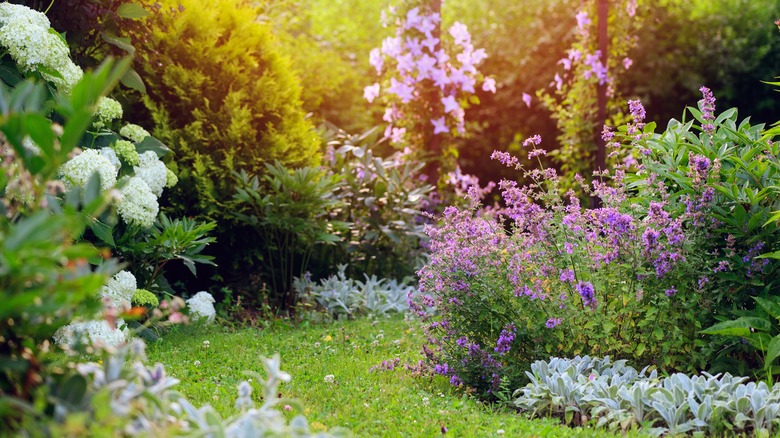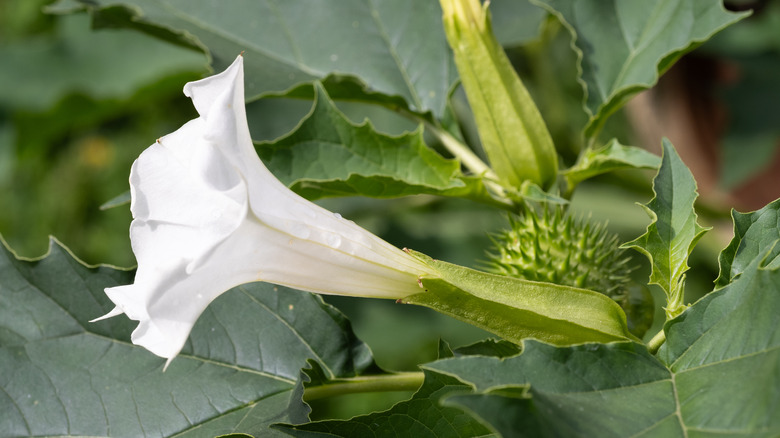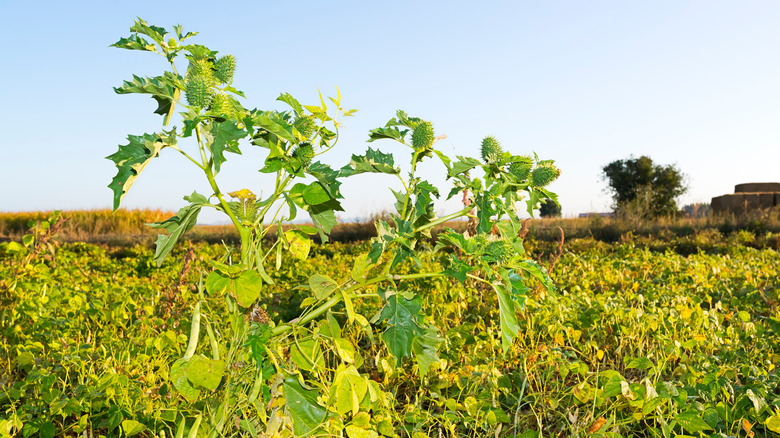The Dangerous Weed That Boasts Stunning Flowers (But Should Be Avoided At All Costs)
Don't be deceived by its gorgeous blooming flowers — there is much more to this plant than meets the eye. Datura stramonium, commonly known as jimsonweed, thorn apple, or devil's trumpet, is a weed that is far more sinister than it appears. Its beautiful white and purple flowers are known to pop up around many parts of the North America and throughout the world. And while the flower may seem harmless, it's anything but.
Although it is a friend to pollinators, jimsonweed is very dangerous to humans and animals. The plant and its seeds contain alkaloids, many of which are toxic when ingested. The side effects are severe and people or animals could become accidentally poisoned. It is one of those scary weeds in your yard to destroy right away, especially if you have children and pets. Thankfully, there are several ways to remove jimsonweed safely from your property and prevent future regrowth. First and foremost, it's important that you are able to identify jimsonweed so that you can take action quickly and keep your loved ones out of harm's way.
What to know about jimsonweed and how to identify it
Due to its unique trumpet-shaped petals, jimsonweed may seem like a beautiful plant, but it's actually an invasive weed. Jimsonweed is a nightshade plant that grows in North America, especially in southern Canada and United States, except for colder regions in the Midwest. It sprouts from late spring to summer and is mostly found in rural areas, pastures, roadsides, farmland, open fields, and waste lots. The plant produces a fragrance at night that attracts pollinators. However, upon closer inspection, you'll notice that the plant also has a foul smell, which leads many animals to avoid it completely.
Although some cultures have used jimsonweed as a natural medicine to treat various ailments, the plant leaves and its black seeds can be incredibly toxic to humans. Research published in the West Virginia Medical Journal says that ingesting jimsonweed can cause symptoms such as a fast heart rate, hallucinations, blurred vision, and confusion. More severe poisonings can lead to seizures, comas, and in rare cases, death. If left to its own devices, jimsonweed plants can grow up to 5 feet tall. The more it proliferates, the greater the risk of poisoning among animals, curious children, and people who don't know about its dangers. That's why it's important to catch and eliminate jimsonweed from your property as early as possible.
Here are the steps to safely remove jimsonweed from your yard
If jimsonweed is growing on your property, there are several methods you can use to remove it safely. It's worth noting that it may take a long time to remove all traces of it from your yard, as this weed is tenacious. Hand pulling is one of the least harmful ways to kill weeds in your lawn. If you are lucky enough to catch it in its early growing stages, jimsonweed can be removed by hand or with garden tools relatively easily thanks to its shallow root system. Although toxic when ingested, the plant does not cause skin reactions. However, it is best to wear long sleeves and protective gloves when pulling weeds by hand. Double bag the plant when discarding it to the trash and consider mulching over the area to prevent regrowth.
If you're struggling to keep the plant under control or the jimsonweed is too widespread, consider contacting professional landscaping services. As a last resort, you can consider treating it with herbicides. Herbicides used to control broadleaf weeds, such as ones containing 2,4-D, will be effective against this dangerous plant. Be sure to follow the directions carefully to avoid harming your grass or other nearby plants. With these measures, jimsonweed doesn't stand a chance in your yard, and you can instead plant beautiful, non-toxic alternatives such as asters, bee balm, coral bells, or creeping phlox to keep weeds out of your garden for good.


